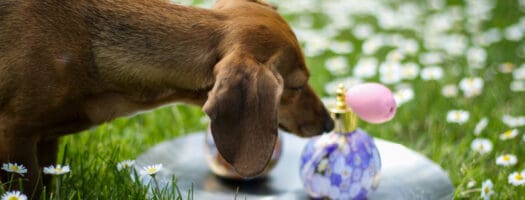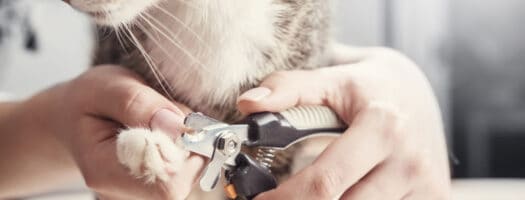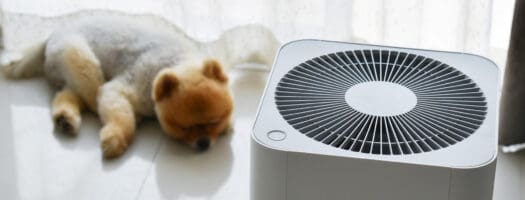The 9 Best Planted Tank Substrates to Buy in 2025
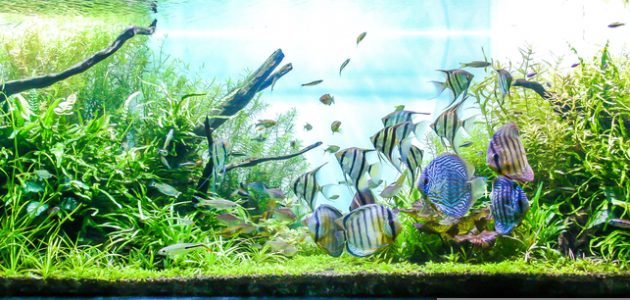
When it comes to building a planted tank, there’s no real answer for “Which substrate is best?” Every set-up has different needs, different water, and will be cared for by a different person. Each tank will be unique, and so picking the right substrate makes for a difficult task. When it comes to planted tanks, aquarist forums are flooded with opinions on which brands are worth it, which brands are a total rip-off, and which growing technique is king.
For the most part, though, arming yourself with a few basic tips is enough to set you on the right path. Starting a hobby as an aquarist is all about trial and error. While you may melt a few plants, have an algae bloom, kill a few fish, or inexplicably lose a snail or two, choosing the right substrate is one way to help prevent such issues. However, don’t take your hiccups as failures—we’ve all had them.
For experimenting with your first tank, it’s important to pick supplies that will get you the aquascape you envisioned without overspending when you don’t need to. We’ve narrowed down our top choices for substrates to make finding the right match just a little bit easier.
- What to Consider in a Tank Substrate
- Top 9 Best Planted Tank Substrates 2025
- 1. Best Overall Substrate: Seachem Flourite Black
- 2. Best Budget Substrate: Carib Sea Eco Complete Black
- 3. Best Premium Substrate: Fluval Plant and Shrimp Stratum
- 4. Best Beginner Substrate: Carib Sea Super Naturals River Sand
- 5. Easiest Substrate to Use: Spectrastone Shallow Creek Aquarium Gravel
- 6. Most Natural-Looking Substrate: Carib Sea Super Naturals Aquarium Sand
- 7. Best Substrate for Simple Tanks: Landen Aqua Soil
- 8. Best for Cichlid Tanks: Carib Sea African Cichlid Mix
- 9. Best Basic Substrate: Imagitarium Black Aquarium Sand
- Guide to Buying the Best Planted Tank Substrates for 2025
- Wrapping Up
What to Consider in a Tank Substrate
When setting up your first tank, first ask yourself how much time, effort, and research you’re willing to put into it. This determines what kind of tank set-up you’re going to go for—did you want something simple and easy to maintain, or extravagant and time-consuming? How much are you willing to spend to achieve the aquascape of your dreams?
Once you’ve figured that out, you can begin plotting. We’d recommend tallying a general cost of your tank set-up before buying anything, so there are no surprises down the line. When it comes to aquarium accessories, prices can vary wildly for what seems like extremely similar products: there are dozens of filters, heaters, bubblers, lamps, and fertilizers that can be time consuming to sift through. At the very least, we’ve done some of the work right off the bat: here are a few characteristics you can look out for in tank substrates that can help you determine which is right for your new tank.
Inert Substrates vs Aqua Soils
The two main types of substrate that you can buy are inert substrates (composed normally of baked clay, sand, or gravel), which have very little in the way of nutrients, and aqua soils (made of hard-baked soil pellets), which are extremely nutrient rich. While it may seem at first glance that aqua soils are the way to go, read on to see if this is the right decision for your tank.
Grain Size & Hardness
How fine your substrate is will determine several things about your tank, such as which plants will survive in it, which livestock you can have, and which filters you can use. Different grain sizes are only suitable for certain tank styles. Finer sand, for example, may be aesthetically pleasing in some set-ups, but can be kicked up too easily by some fish species—and get sucked into your now gunked-up canister filter. Meanwhile, larger substrates may be too difficult for your plants to root in, making them unsuitable for some plant types.
Cation Exchange Capacity (CEC)
You may see this phrase popping up here and there when looking for a tank substrate, as some brands like to market high CEC values to put their product above the rest. In short, CEC refers to a soil’s ability to retain essential nutrients. It might seem like an important thing to look for in a substrate, but most of the time, it isn’t. In a controlled tank environment, where you can replenish nutrients yourself and monitor water pH, the actual CEC value of a commercial substrate doesn’t make a whole lot of difference. Over time, the natural organic hummus (such as from plant and fish waste) of your tank will help your soil retain nutrients anyways.
Plant and Livestock Types
The plants you plan to stock your aquarium with can determine how much you need to spend on a substrate. Depending on the way a plant feeds, or where you decide to put them, you can get away with much cheaper options. Root-feeding plants such as Amazon Swords, for example, can grow well in cheaper inert substrates, as long as they are provided nutrients via root tabs. As well, some fish types prefer certain kinds of substrates. African Cichlids, a popular tank breed, can’t tolerate softer water—so nutrient-rich substrates (which can lower pH) may actually do them harm.
Ease of Care
Some substrates are far easier to set-up and maintain than others. Inert substrates like coarse sands, gravels, and clay pellets lend themselves well to siphon cleaning, while aqua soils can often end up as muddy messes if disturbed. Aqua Soils also need replacing eventually, which can involve a complete tear-down of your tank when their nutrients are depleted.
Appearance
When planning your first aquascape, keep your end-goal in mind. How do you want to frame your tank? What accent colors do you want? Which biome are you modeling your tank after? While you don’t always need to consider all these things (especially for your first aquascape), it’s where you can have the most fun! Play around with different ideas for plant types, layout, and hardscape (rocks, sticks) before picking up a substrate to match.
Now that you know what to consider in a plant substrate, let’s check out the best ones on the market today.
Top 9 Best Planted Tank Substrates 2025
1. Best Overall Substrate: Seachem Flourite Black
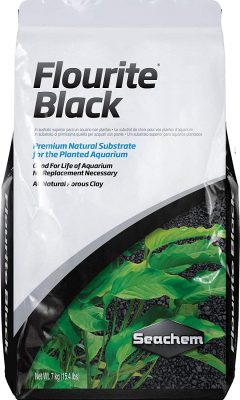
Editor’s Rating:
Why we like it: This is a gorgeous, easy-to-use substrate that is our go-to for a beginner tank.
Quick Facts:
- Substrate Type: Inert
- Cost Per Lb.: Low
This inert substrate is a fantastic pick for your first planted tank. The cost is reasonable per pound, it won’t deplete over time, and it’s backed by a company whose high quality has stood the test of time. Flourite Black is porous enough for your plants to root well and allows for proper CEC. This substrate easily takes our top spot, and it’s our personal favorite in our own tanks at home.
As an inert substrate, Flourite Black is easy to maintain once your tank is established. It won’t break down, meaning that if in the future you disturb your tank’s substrate, you won’t end up with a mess of dissolved soil. It’s easily cleaned with a siphon and can be pushed around as needed when you want to move plants or remove hardscape.
If we’re honest, our favorite thing about Fluorite Black is how it looks. Yes, it’s great for the plants, and yes, the cost for quality is great, but this takes our top spot because it just looks so fantastic. Even after rinsing, this substrate maintains its rich black color, making fish and plants pop. It has a beautiful, natural look that suits a wide variety of aquascapes, and is a great substrate to combine with white sand for a stunning modern look.
A few words of caution: if you don’t rinse this product thoroughly, it will cloud up your tank. We’d recommend a long rinse or two in a fine colander or mesh screen, then testing the substrate by submerging it in a bucket to make sure the water is clear. Remember that the cleaner you get the substrate first, the less dust gets in your filter medium (which you’d then need to replace).
As well, Flourite Black’s porosity means that it may not be heavy enough for all situations. You might have trouble holding down some finer aquarium plants (such as Dwarf Baby Tears, a popular beginner plant), so mixing this substrate with a black sand can help to add weight if you need it.
Pros
- Gorgeous aesthetics
- Low maintenance after initial set-up
- Porous
- Great value
Cons
- Needs a lot of rinsing in initial set-up
- Too light on its own for some plants
2. Best Budget Substrate: Carib Sea Eco Complete Black
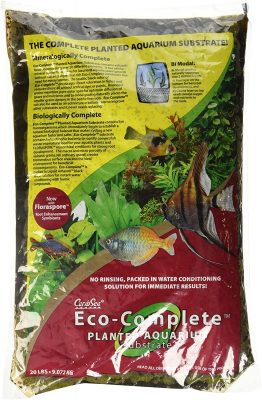
Editor’s Rating:
Why we like it: Doesn’t hurt the wallet, looks great, and easier to clean than other aqua soils.
Quick Facts:
- Substrate Type: Aqua Soil
- Cost Per Lb.: Low
While this is technically an aqua soil, Eco Complete is slightly different than most others. We’d consider it partly aqua soil, partly inert substrate, because even though it has minerals that deplete over time, it behaves somewhat like traditional aquarium gravel. Eco Complete is heavier than most traditional aqua soils, meaning that it can more easily hold large plants and won’t be as difficult to siphon. Small/very light plants, however, may be difficult to root in this substrate, as it’s on the coarser side. While slightly less nutrient-rich than our Fluval Plant and Shrimp Stratum, Eco Complete is also lower maintenance, especially over time.
For a beginner tank, a substrate like Eco Complete may be on the difficult side to start with. Because of the nutrients it releases, it can be a tough task to perfectly balance your water parameters to make them safe for your fish. Things like pH fluctuations and ammonia spikes can spell doom for your livestock, so if you have a tank with livestock in it already, we don’t recommend adding Eco Complete (or any aqua soil) unless you know you can balance your water parameters properly.
Pros
- Very little/no rinsing required
- Doesn’t cloud water
- Easy to clean
- Enough nutrients to support many plants
Cons
- Hard to root smaller aquarium plants
- Can cause dangerous spikes in water parameters when added to established tanks
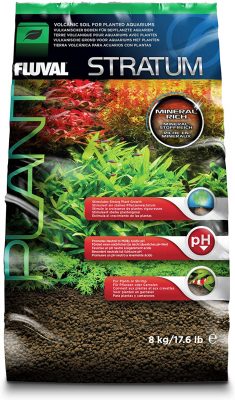
Editor’s Rating:
Why we like it: Not only is this aqua soil gorgeous, but it’s packed with enough nutrients to let you grow yourself a stunning underwater jungle.
Quick Facts:
- Substrate Type: Aqua Soil
- Cost Per Lb.: High
There’s a good reason why this aqua soil is an extremely popular choice amongst aquarists. It’s a favorite amongst aquarium YouTubers such as The Water Box, as well as a mainstay in aquascape competitions. While it definitely costs more than the average substrate, it has years of stellar quality to back it up. This aqua soil is nutrient rich, facilitating amazing plant growth without the need for root tabs for a very long time, and has a rich color that makes the lush jungles it can support stand out.
Keep in mind that this aqua soil is fairly light, and so is more difficult to siphon than an inert substrate like Fluorite Black. Capping this aqua soil with a thin layer of inert substrate like Spectrastone’s will allow for easier cleaning, as well as help prevent messes when plants are disturbed. Be careful when doing any re-modeling with this aqua soil, or you might crush the pellets and muddy your water.
For your first set-up, we’d recommend a very gentle rinse in a bucket (the pellets are delicate, so go slowly) to prevent clouding. In general, though, this aqua soil has far fewer clouding issues than its peers. Once you’ve got the hang of how this aqua soil behaves in the water, you shouldn’t have any more problems.
Pros
- Needs very little rinsing (if any)
- Nutrient-rich
- Looks fantastic
- Long track record
Cons
- Fairly expensive
- Hard to maintain over time
4. Best Beginner Substrate: Carib Sea Super Naturals River Sand
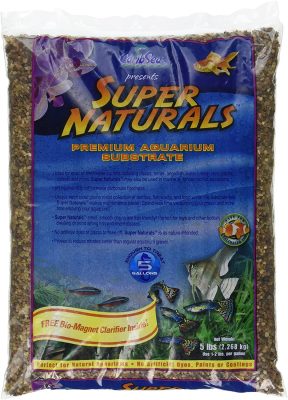
Editor’s Rating:
Why we like it: Easy to use, has a great natural look, and super easy to maintain. This is a great pick for any beginner tank.
Quick Facts:
- Substrate Type: Inert
- Cost per Lb.: Moderate
We’d call these grains “fine gravel” over “sand,” but we can’t hold that against Carib Sea too much, because this is a great substrate. It has a different aesthetic than most black or white sands, with flecks of red, brown, and quartz, lending your tank a look that seems peeled from a natural creek. It’s fineness also means that it’s soft enough for bottom-feeding fish like Corydoras, who can be harmed by gravels with sharp edges.
For a beginner tank, this gravel is easy to rinse, set up, and clean. The gravel is heavy enough to avoid being sucked into a siphon, even when you get a little bit too close. This substrate’s weight also makes it ideal for holding down large rooted plants, while the grain size makes it porous enough to facilitate healthy root systems. In a more advanced tank, this is a great substrate for color accents or for a heavy cap to hold down an aqua soil.
Pros
- No-fuss, simple substrate for your first planted tank
- Smooth enough for bottom-feeders
- Unique colors and grain size
Cons
- Clouds water when not rinsed very thoroughly
- Name implies this is fine sand, which it isn’t
5. Easiest Substrate to Use: Spectrastone Shallow Creek Aquarium Gravel
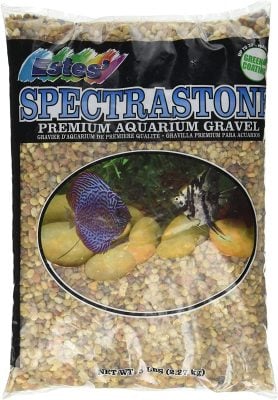
Editor’s Rating:
Why we like it: Natural, simple-to-set-up gravel that beginners will have no problems with.
Quick Facts:
- Substrate Type: Inert
- Cost Per Lb.: Low-Moderate
This substrate’s main qualities can be summed up very easily: it’s just rocks.
As such, there are no surprises, and you know exactly how it’s going to behave. When setting up a beginner planted tank, there are so many parameters to keep track of that it can sometimes be overwhelming. For a low-tech, low-light plants set-up, there’s no easier place to start than “just rocks.”
Because this product isn’t dyed, you don’t need to worry about chemicals leaching into your water, and it’s easy to rinse for the initial set-up. As this substrate is simply composed of natural pebbles, you can more safely add it to an already established, stocked tank without worrying about nutrient/ammonia spikes. These larger pebbles are also exceptionally easy to clean with a siphon. Just hover the siphon right above them and watch as this heavier substrate simply settles itself back down when you move on.
Note: as this substrate is rock, it may have sharper pieces from breaking in shipping, making this substrate not suitable for Corydoras.
Pros
- Inert media with very little impact on an established tank
- Nothing fancy—you know what you’re getting
- Won’t cause algae blooms or ammonia spikes
Cons
- Not very “pretty” compared to other substrates
- May be too sharp for Corydoras
6. Most Natural-Looking Substrate: Carib Sea Super Naturals Aquarium Sand
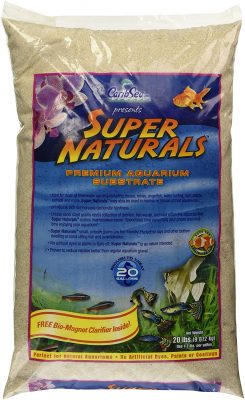
Quick Facts:
- Substrate Type: Inert
- Cost Per Lb.: Low
When you just need a good aquarium sand, this does the job. It’s safe to add to established aquariums, doesn’t cloud the water very much, and rinses easily. It’s important to note that this sand doesn’t contain crushed coral, as most natural-looking aquarium sands do (as many are formulated for reefs). This means that it won’t cause issues with your water’s pH.
The coarseness of this sand is great for supporting rooting plants. Coupled with root tabs, this type of sand is perfect for growing a forest of Amazon Swords. Unlike substrates with larger grains, this sand won’t allow detritus to reach your root systems. If you decide to grow rooting plants in this substrate, make sure that you stay on top of root feedings properly, as your tank won’t be able to replenish its own nutrients.
Be careful when choosing a filter if you’re going to use sand in your aquarium. Under gravel/canister filters, especially, are susceptible to filling themselves with tiny sand particles and clogging up.
Pros
- No crushed coral
- Doesn’t cloud water much at all
- Has a gorgeous natural look
- Great for Amazon Swords, Anubias, and Red Leaf Ludwigia
Cons
- Not good for canister filters
- Doesn’t allow detritus to root systems
7. Best Substrate for Simple Tanks: Landen Aqua Soil
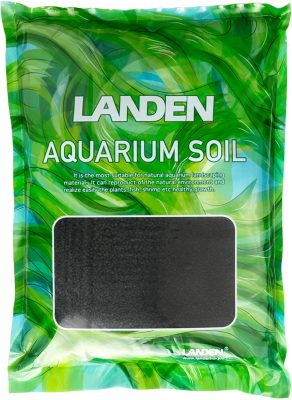
Editor’s Rating:
Why we like it: An up-and-comer making its way through aquarist forums, Landen provides an alternative to established, more expensive brands.
Quick Facts:
- Substrate Type: Aqua Soil
- Cost Per Lb.: Moderate
While this is a lesser-known aqua soil brand compared to giants like Seachem or Fluval, Landen has gained some traction in recent years amongst aquarists online for its budget friendliness. It’s no-nonsense and nothing special, but it gets the job done.
This aqua soil’s nutrients release slowly, making its longevity in a tank comparable to its peers, and it doesn’t cloud the water very much upon set-up. We’d recommend this substrate for a simple beginner tank with low-light plants, rather than a fully stocked jungle, as it isn’t as nutrient-packed as some other aqua soils.
Pros
- Facilitates healthy plant growth
- Fair value for price
- Releases nutrients slowly
- Doesn’t cloud water
Cons
- Less nutrient-rich overall than premium brands
- Not good to add to already established tanks
8. Best for Cichlid Tanks: Carib Sea African Cichlid Mix
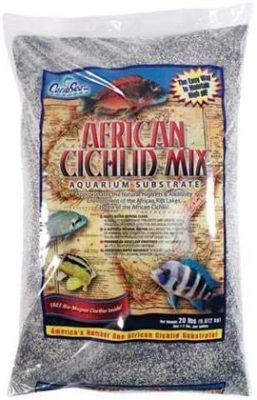
Quick Facts:
- Substrate Type: Inert
- Cost Per Lb.: Low
A popular, vibrant aquarium fish, cichlids have different needs than typical beginner breeds. For a beginner cichlid tank, we don’t recommend using any sort of aqua soil, as balancing the pH and nutrient levels that Cichlids need to stay healthy is much harder with those kinds of substrates. Instead, we’d recommend choosing an inert substrate mix that’s specifically formulated for this species. This one from Carib Sea is straightforward, cost-effective, and looks great paired with the large rocks and heavy hardscape typical of cichlid tanks.
When choosing plants for your cichlid tank, remember that they’re a fish notorious for digging up plants and small decorations. For cichlid owners, it’s not uncommon to wake up one morning and find their newly planted Hornwort floating at the top of the tank. Because of this, try choosing plants that can be tied down to heavy hardscape or baskets, rather than simply burying them in the substrate.
To clean this substrate, we’d recommend trying the “cichlid bottle method” in order to prevent water clouding.
Note: While this substrate is marked as black, it’s actually black with white flecks.
Pros
- Designed for use with cichlids
- Affordable
- Looks wonderful with large rocks and heavy hardscapes
Cons
- Not actually a black substrate
9. Best Basic Substrate: Imagitarium Black Aquarium Sand
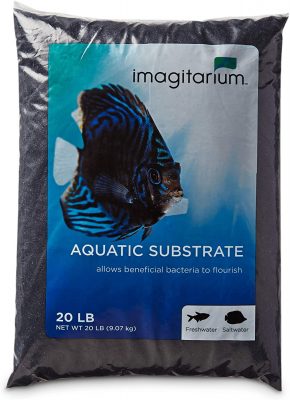
Quick Facts:
- Substrate Type: Inert
- Cost Per Lb.: Very low
Sometimes you just need sand, and this is it. This one’s cheap, and you get a lot of it. What more can you ask for?
If you want a cap for a light substrate or want an accent to contrast with your plants or decorations, choosing a black sand is the perfect way to add a modern pop to your aquarium. This substrate’s grains are coarse enough to support rooting plant life and will allow a small amount of detritus through—but not enough that you can slack off with root tab feedings. This sand is a bit on the lighter side, so you may have trouble rooting larger plants. We’d suggest this sand for tanks with plants that can be attached to hardscape, such as Anubias, or simply arranging your tank so that your hardscape aids in holding your plants down. Keep in mind that if you have fish who enjoy digging around plants and pulling them out, this sand won’t be able to stop them.
We put this one at our tenth spot because while it’s a great value and looks great once it’s in the tank, it’s very labor-intensive at first set-up. The rinsing process on this sand is lengthy and can be extremely frustrating when the water just won’t run clear.
Pros
- Lowest cost per pound than other substrates on this list
- Won’t change water parameters
- Looks great
- Easy to use and predict
Cons
- Very annoying to rinse
- Not as good for rooting plants as other substrate choices
Guide to Buying the Best Planted Tank Substrates for 2025
Setting up a new tank can be a heavy investment. There are a myriad of tiny factors to consider in every piece that you choose—from your thermometer to your snails, every single thing comes with a laundry list of pros and cons. When it comes to substrates, a little bit of knowledge goes a long way. As opposed to the electronic components of your tank, choosing a substrate has less to do with comparing stats than it does determining how it will fit with your lifestyle and your tank’s future ecosystem. Let’s discuss what you need to know before selecting a substrate for your first aquascape.
Inert Substrates vs Aqua Soils: Which Is Best?
If you’re unsure which option is right for your tank, we’ve got you covered.
What Are Inert Substrates?
Simply put, inert substrates are ones that do not change over time. This includes substrates like gravel, fluorite, sand, baked clay, and rocks. They have very little (if any) nutrients to start with, and as such, will not lose them throughout the life of your tank.
Inert substrates are easy to maintain and can facilitate great plant growth with the addition of root tabs and help from water fertilizers. You won’t see the same level of growth in an inert substrate that you would in an aqua soil, but the tradeoff here is that inert substrates never need to be replaced, are less complex when it comes to water parameters, and are far easier to clean.
What Are Aqua Soils?
Aqua soils (also known as depleting substrates) begin their life in your tank packed full of nutrients and release them over time as they decompose. This category includes commercial-grade soils sold specifically to facilitate planted-tank growth.
Aqua soils came about to mitigate the main problems associated with using regular soil in tanks. Regular soil turns water muddy when kicked up (ever thrown a big rock into a pond?), turning a beautiful aquarium into an ugly mess. While this can be solved by covering the soil with a harder, denser substrate (like sand or gravel) known as a “cap,” this only works so long as the soil underneath is still never disturbed. Which, as any aquarist will tell you, is exceedingly difficult to do—when plants need to be fed nutrients, that soil is going to be moved.
While aqua soils definitely improve on regular soil, as they’ve been packed into pellets and break down slowly, they aren’t permanent. They might be easier to set up, but after about 6 to 10 months, their nutrient stores begin to deplete, and they start to behave like regular soil and need to be replenished somehow.
Which Type Should You Buy for Your Tank?
A quick and easy answer for some would be to invest in a decent aqua soil, as often, that is all you’d need to get a planted tank started off right. But depending on your skill level, and what you plan to do with your tank, spending that much money on an aqua soil (they don’t come cheap, especially when you need to fill a larger tank) may not benefit you.
If this is your first tank, a simple option may be an inert substrate like Fluorite Black or Super Naturals River Sand. For plants that mainly feed from the water column, such as many rhizome (like Anubias, Java Ferns) and floating plants (like Marimos, Duckweed, Amazon Frogbit), substrate plays little role in their overall health. In this case, a substrate can be picked mainly for aesthetics or for cost. There’s really no need to shell out the big bucks for these types of plants. Even some stem plants, like Amazon Swords, don’t care if the gravel they’re rooting in is clay pellets or fancy aqua soil. As long as they receive nutrients via root tabs, they can be grown in any substrate that is loose enough for their roots to sink deep.
If you’re going for a lush, watery jungle though, an aqua soil is going to be the best pick. While some plants can be grown perfectly fine in inert substrates, most will do best when planted in a proper, nutrient-rich aqua soil. Because aqua soils change water parameters substantially, though, we’d recommend starting off a tank with a long cycling period and testing the water thoroughly before adding any livestock.
What Size Should My Substrate Be?
When it comes to grain or pellet size, a general rule of thumb is that most substrates are perfectly fine around 1mm-5mm. Very fine sand, for example, should not be used as your aquarium’s main substrate, as it can compact and prevent plants from being able to root. On the other extreme, large stones can leave too much room between them for your plants to establish proper root systems.
Any commercial aqua soil is going to be suitable for the vast majority of aquarium plants (barring a few, more exotic plant species that likely aren’t going to make it into a beginner’s tank). Our choices for aquarium sands, like Super Naturals River Sand and Imagitarium Black Aquarium Sand, are not super-fine, and so are suited for growing rooting plants.
How Should I Maintain My Substrate?
Following these tips well help keep your substrate and tank looking and functioning their best.
Clearing Waste
In any tank, organic waste material will build up in your substrate. If you have livestock, this can include things like unused food or fish waste, but can also include old leaves, decaying roots, and dead algae. The buildup of all this waste leads to algae blooms (as nitrite levels rise), the melting of aquarium plants, and unhealthy water for livestock.
While a small amount of organic waste material in your substrate isn’t going to have too much of an impact, there’s no reason to let it build up. In inert substrates, a bit of organic loam is going to add and help it retain nutrients (remember the term CEC?), but you should still aim to keep it mostly clear of detritus. In an aqua soil, there’s no reason at all to let waste build up. Any aqua soil worth the money is going to have enough nutrients to facilitate plant growth on its own, and heavy detritus buildup will wreak havoc with your water’s delicate nutrient and ammonia balance.
Use a siphon to clear the top of your tank’s substrate about once every 1-2 weeks (just add it to your regular water-change schedule), depending on how fast you see detritus collecting. Two good options are this one from Python (for larger tanks), or this cheaper option from Terapump, great for smaller beginner tanks. Remember not to actually touch the substrate with the siphon—hover it gently above the substrate without disturbing it too much. To get a better idea of how to do it, watch a few videos from fellow aquarists (like our favorite, Joey, The King of DIY) and copy their technique.
Replenishing Nutrients
Eventually, an aqua soil tank will need to be renewed completely (this involves removing the plants and livestock, completely emptying the tank, replacing the substrate, and cycling the tank again), but keeping the soil well-stocked with nutrients can delay this inevitability for many years.
Water table fertilizers like Seachem’s Flourish Advance or root tabs like their Flourish Tabs can help you maintain nutrient levels once your substrate begins to deplete. We’d recommend using root tabs immediately when setting up a planted tank with an inert substrate. They’re easy to use and provide enough nutrients for most varieties of aquarium plants—just press them into your substrate, and that’s it. To make landscaping and inserting root tabs easier, pick up a set of aquascaping tools, like these from Jeeco.
How Much Substrate Do I Need?
In general, a depth of 2 inches of substrate is sufficient for plant growth. If you’re going to have an aqua soil capped with an inert substrate, aim for no more than 3 inches in total height, where 2 inches are the aqua soil and 1 inch is the cap. Try using this substrate calculator to determine how much you may need approximately.
Some Quick Tips for Setting up a New Tank
New to setting up an aquarium? We’ve got all the advice you need to get set up with your new tank!
Rinse Inert Substrates Properly
With inert substrates, there comes the expectation that you’re going to clear it of dust and dirt before it goes in your tank. When you look at some of substrates we’ve selected, you’ll see more than a few complaints about a fresh substrate clouding the water. This is, more often than not, a result of improper rinsing before adding to a tank. Keep going until the water runs clear. It usually takes longer than you think it will—some substrates need several rinses and soaks before they’re completely clean. This doesn’t mean the substrate is of low quality, or that it will ruin your tank. All you need is a proper first set-up, and there should be no more issues with cloudy water.
Buy a Bucket Just for Your Aquarium Right Away
In all the excitement of buying substrates, decorations, a tank, hardscape, and all the fun things you can put in your tank, a bucket doesn’t always cross your mind. But you’re going to need a bucket for everything throughout your tank’s life: such as rinsing substrate, cleaning rocks and driftwood, conditioning water, holding livestock, siphoning gravel, and more. It’s an absolutely indispensable tool that no aquarist can go without. Remember that you can’t just use an old bucket from the basement—if it’s ever been used for soap or other chemicals, those chemicals can leech into your tank water from the bucket’s plastic.
Take Any Product’s Claim of “Won’t Cloud Water” With a Grain of Salt
Yes, there are some products that cloud more than others, but you should expect that some amount of clouding is always possible when a substrate is first added to a tank, no matter what you buy. If you do have clouding issues and can’t seem to fix it, give API’s Accu-Clear a shot.
Don’t Skip the Cycling Period
While you might be excited to stock your tank with new fish right away, doing so could end up killing them. If you are using an aqua soil, especially, we’d recommend cycling the tank for 2 weeks before adding any fish, shrimp, or snails.
Wrapping Up
One last word of advice: if you’re setting up a planted tank for the first time, don’t expect perfection. The best part about getting into the aquarium hobby, in our opinion, is learning what works and what doesn’t, trying new growing methods, and fiddling with your tank until it’s exactly the way you want it. There’s a whole ocean of knowledge out there, and long-time aquarists have spent years exploring it. No need to stress if you dip your toes in and the water is too cold.
